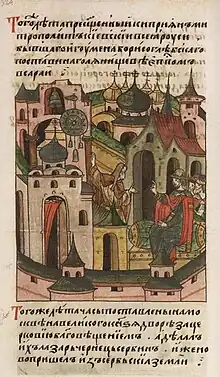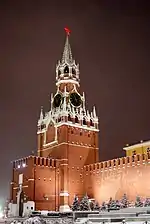Lazar the Serb
Lazar (Serbian: Лазар; Russian: Лазарь), also known as Lazar the Serb or Lazar the Hilandarian[a] (fl. 1404), was a Serbian Orthodox monk-scribe and horologist who invented and built the first known mechanical public clock in Russia in 1404. The clock, which also struck the hours, was built at the request of Grand Prince Vasily I of Moscow (r. 1389–1425). Prior to his arrival in Moscow, Lazar had served as a monk in the Serbian Hilandar monastery at Mount Athos. The clock tower was located in the palace behind the Cathedral of the Annunciation. However, the clock and the church in which it was located have not survived.
Lazar the Serb | |
|---|---|
 Lazar the Serb showing his clock tower to Vasily I of Moscow, miniature from the Illustrated Chronicle of Ivan the Terrible | |
| Born | mid-14th century |
| Died | after 1404 |
| Known for | Inventing the first mechanical clock in Russia, which was also the country's first public clock |
| Scientific career | |
| Fields | Invention |
Life
A Serb, Lazar was born in the town of Prizren, in the Serbian Empire. He was a monk with the rank of crnorizac (Serbian: црноризац; Russian: чернец, romanized: chernets) serving at the Serbian Orthodox Hilandar monastery, a centre of Serbian religious and secular culture[1] and "the first Serbian university",[2] located on Mount Athos.[3][4] Lazar likely left Mount Athos as a result of the Rise of the Ottoman Empire.[5][6] Russian chronicles speak of Lazar, newly arrived from Serbia, inventing and building a clock on a tower in the Grand Prince's palace in Moscow behind the Cathedral of the Annunciation at the request of Vasily I, the Grand Prince of Moscow (r. 1389–1425).[4][7][8][9][10] It was the first ever spring-driven (mechanical) clock, or striking clock, in Russia, and also the country's first public clock.[4][8][9][10][11] The clock numbers were written in Church Slavonic.[6] It was among the first ten such advanced clocks in Europe,[12] and was regarded a technical miracle at the time.[6] Clocks in urban towers, or municipal hour signals, did exist earlier in Italy, though it is not known how they indicated the hours. In 1344, Paduan chronicles confirmed an entirely new technology – a clock in a tower at the Paduan palace which automatically struck the hours (24h).[13]
This hour-marker is called an hour-measure; each hour a hammer strikes the bell, measuring and counting the hours of the night and of the day . . . No man strikes it, but it is somehow wondrous strangely fashioned to look like a man and sound and move of itself, by man's cunning, with great invention and cleverness.
— A description of Lazar's clock[14]
The clock tower has not survived, and its exact location is undetermined, although it is believed to have been located at or near the Spasskaya Tower (formerly known as Frolovskaya).[15][16] The clock was for a long time the only one in Moscow and Russia,[17] and worked for more than two centuries without failure.[3][6] It was then replaced by another clock which was destroyed in a fire.[12] A miniature from the 16th-century Ostermanovskij manuscript (of the Litsevoy Collection of Chronicles, Ancient Chronicle, sheet 587, drawing 1175[7]) exists which depicts the monk Lazar showing Vasily and two of his vassals the finished clock tower.[14][18] Although the tower is gone, the illustration of the clock tower and monastery can be seen in the Polytechnical Museum in Moscow as of 2006.[4] A 16th-century chronicle says that Lazar was paid 150 rubles for his work ("sta bole polutorasta rublev").[19][20]
Legacy

The Serbian Orthodox Church decided to celebrate the 600th anniversary of the monk Lazar's invention and construction of the great clock tower in the Moscow Kremlin on the feast of the Presentation of Mary (Ваведење) on 4 December 2004. The liturgies of the churches in Belgrade and Moscow, the Hilandar (where the brotherhood had their krsna slava) and the Monastery of the Holy Archangels, mentioned Lazar.[3] A memorial sundial was placed on the Academy of the Serbian Orthodox Church in Belgrade.[3][6]
The Serbian mathematician Dr. Dragan Trifunović noted Lazar and his invention as part of Serbian mathematics of the Middle Ages,[4] saying that "as a mathematician it was interesting how Lazar forged the clock. He had to have knowledge of Archimedes' division of circuit tracks and estimation of the extent to forge three types of gear wheels. I have proposed to the Kremlin to put up a plaque with an inscription where the clock tower once stood."[4]
Along with Pachomius the Serb, Lazar is one of the notable Serbs in Russian medieval history.[21]
See also
- List of Moscow Kremlin towers
- Teodosije the Hilandarian (1246-1328), one of the most important Serbian writers in the Middle Ages
- Elder Grigorije (fl. 1310-1355), builder of Saint Archangels Monastery
- Antonije Bagaš (fl. 1356-1366), bought and restored the Agiou Pavlou monastery
- Lazar the Hilandarian (fl. 1404), the first known Serbian and Russian watchmaker
- Pachomius the Serb (fl. 1440s-1484), hagiographer of the Russian Church
- Miroslav Gospel
- Gabriel the Hilandarian
- Constantine of Kostenets
- Cyprian, Metropolitan of Kiev and All Rus'
- Gregory Tsamblak
- Isaija the Monk
- Elder Siluan
- Grigorije of Gornjak
- Atanasije (scribe)
- Rajčin Sudić
- Nicodemus of Tismana
- Dimitar of Kratovo
- Marko Pećki
Annotations
- ^ His name was Lazar (Russian and Serbian: Лазар). Russian documents call him Monk Lazar the Serb (чернец Лазарь Сербии, Србин Лазар черњец).[3] Modern sources also specifically call him Lazar the Serb (Russian: Лазарь Сербии, Лазар Серб,[18] Serbian: Србин Лазар), Lazar the Hilandarian (Russian: Лазар Хиландарец,[18] Serbian: Лазар Хиландарац) and Monk Lazar (Serbian: Монах Лазар).[21]
Notes
- Parry 2010, p. 233
- Upadhya 1994, p. 65
- Архимандрит Мојсије 2004
- Trifunović 2006
- Tsonev 1976, Mŭdrostta na starite charkove, p. 24:
*... монах Лазар [86, стр. 416]. Неговото идване в Русия от манастирите на Атон подсказва, че бившите земи на Византийската империя и след падането на Балканите под турска власт продъл- Фиг. 2. 1. Часовников механизъм с ...
- Radetić 2004
- Uliyanov 2005
- Matica srpska 1965, p. 284
- Tošić & Tadić 2004
- [[#CITEREFRaduga_Publishers1984|Raduga Publishers 1984]], p. 63
- Astronomska opservatorija u Beogradu 1999, p. 93
In the year 1404 a monk from the Mons Athos named Lazar, a born Serb, made in Moscow, at the court of the great duke Vasilij Dimitrović, the first tower clock which struck hours
- Blečić 2011
- Rossum 1996, p. 109
- Rossum 1996, p. 110
- British Scientific Instrument Research Association 1961, p. 4
-
A mechanical tower clock appeared in Russia in 1404 during the reign of Prince Vasilii Dmitrievich, son of Dmitrii of Don. This clock was mounted in Moscow on the Frolovskaya (Spasskaya) tower of the Kremlin.
- Sovinformbiuro 1972
For a long time Lazar Serbin' s clock . . .
- Григорьян & Меркулова 1981, p. 71
- Miller 1989, p. 382
- Radetić 2004:
"U leto 6912. (1404) veliki knez (Vasilij Prvi) naumi časnik (časovnik) i postavi ga na svome dvoru kod crkve Sv. Blagovesti... Majstor i umetnik ovoga beše neki monah, koji je došao sa Svete gore, rodom Srbin, po imenu Lazar, a cena ovome beše 150 rubalja..."
- Davidović 2003, p. 25
References
- Архимандрит Мојсије (December 3, 2004). "600-ТО ГОДИШЊИЦА ЧАСОВНИКА ЛАЗАРА ХИЛАНДАРЦА У МОСКВИ". Belgrade: Hilandar.
- Astronomska opservatorija u Beogradu (1999). Publications de l'Observatoire astronomique de l'Université de Belgrade. Nauchna knjiga.
- Blečić, Petar (March 27, 2011). "Srbi časovničari dva veka pre Švajcaraca". Belgrade: Blic Online.
- Davidović, Blagoje (2003). Srbi u istoriji Rusije. Narodna knjiga–Alfa. p. 25.
- British Scientific Instrument Research Association (1961). Soviet Instrumentation and Control Journal. British Scientific Instrument Research Association.
- Григорьян, Ашот Тигранович; Меркулова, Наталья Михайловна (1981). Исследования по истории механики. Институт истории естествознания и техники (Академия наук СССР). p. 71.
- Matica srpska (1965). Zbornik Matice srpske za književnost i jezik. Novi Sad: Matica srpska.
- Miller, David B. (April 1989). "Monumental Building as an Indicator of Economic Trends in Northern Rus' in the Late Kievan and Mongol Periods, 1138–1462". The American Historical Review. Oxford University Press. 94 (2): 360–390. doi:10.2307/1866831. JSTOR 1866831.
- Radetić, M. (December 4, 2004). "Šest vekova Lazarevog sata". Novosti.
- Raduga Publishers (1984). The Kolomenskoye Museum-Preserve: a guide. Raduga Publishers. ISBN 9785050000705.
- Rossum, Gerhard Dohrn-van (1996). History of the Hour: Clocks and Modern Temporal Orders. Chicago: University of Chicago Press. pp. 109–111. ISBN 0226155110.
- Sovinformbiuro (1972). The Daily Review, Volume 18. Agentstvo pechati "Novosti".
- Tošić, Gordana; Tadić, Milutin (2004). Hilandarski monah Lazar, prvi srpski časovničar. Kalenić. ISBN 86-84183-06-1.
- Trifunović, Dragan (November–December 2006). "Matematika u srpskom narodu". Planeta 21.
- Uliyanov, Oleg Germanovich (2005). "The Deesis painted by Andrey Rublev". Makariyevskiye Readings. Issue XII: Hierarchy in ancient Russia. Russia. pp. 172–223. Retrieved 2013-03-31.